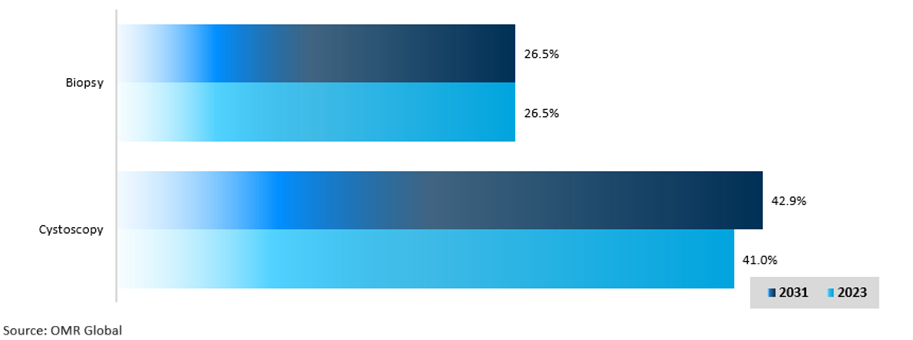The Changing Landscape of Global Bladder Cancer Diagnosis and Treatment
Global bladder cancer market is experiencing a CAGR of 9.8% during the forecast period (2024-2031). Bladder cancer is on the rise owing to aging and lifestyle factors, requiring effective diagnostic and therapeutic solutions. Advancements in imaging, biomarkers, genetic testing, gene therapies, and minimally invasive procedures have improved detection rates and treatment options. Additionally, the improvement in healthcare infrastructure, regulatory environment, and personalized medicine contribute to early diagnosis and effective treatment of bladder cancer.
Cystoscopy Holds the Largest Market Share during the Forecast Period
Based on the diagnosis, the market is segmented into cystoscopy, biopsy, urine cytology, Intravenous Pyelogram (IVP), and others (biomarkers and other imaging tests). Technological advancements,
for more effective bladder cancer diagnostics, early tumor detection, and improving treatment outcomes, are driving the market growth. Cystoscopy is an essential procedure in the diagnosis and treatment of bladder cancer. It utilizes a cystoscope, a slender, flexible tube equipped with a camera, which is inserted into the bladder via the urethra to examine the inner lining of the bladder.
Bladder Cancer Market Size and Forecast By Diagnosis, 2023 vs 2031 (%)

Cystoscopy holds the largest market share of 41.0%, in 2023, and is anticipated to grow at the high CAGR of 7.8% during the forecast period. It is followed by biopsy at 26.5% market share, growing at a close CAGR of 7.2%.
Surgery is anticipated to dominate the Market during the Forecast Period
Based on treatment, the market is segmented into, surgery, chemotherapy, immunotherapy, radiation therapy, and others (targeted therapy and combination therapy). Surgery is a medical treatment that uses both manual and instrumental procedures, such as bladder cancer, which can involve removing cancerous tissues or the bladder itself. Surgery is essential for bladder cancer diagnosis and treatment, with TURBT for early-stage cases and partial cystectomy for muscle-invasive cases. Advancements in robotic-assisted surgeries and minimally invasive techniques improve patient outcomes. Surgery is often combined with other treatments to boost natural defenses.
Bladder Cancer Market Size and Forecast by Treatment, 2023 vs 2027 vs 2031 (%)

Surgery held the largest market share, of 38.0%, in the bladder cancer treatment segment, in 2023, and is anticipated to have a continued dominance during during the forecast period. However, the segment is anticipated to grow at the lowest CAGR, of 9.3% during the forecast period, attributed to the emergence of minimally invasive procedures. On the contrary, chemotherapy is anticipated to grow at the largest CAGR of 12.0% during the forecast period.
Key players in the global bladder cancer market include Merck and Co., Inc., Pfizer, Inc., Johnson & Johnson Service, Inc., GlaxoSmithKline plc., and Astellas Pharma Inc., among others. The market players are contributing significantly towards market growth by the adoption of various business strategies, such as partnerships, mergers & acquisitions, and new product launches, among others.
Few Recent Developments-
- In August 2024, Richard Wolf and Photocure formed a strategic partnership to develop a flexible blue light-enabled cystoscope for photodynamic diagnostics (PDD). The equipment aims to address cystoscopies in outpatients with bladder cancer.
- In December 2023, Ferring received FDA approval for Adstiladrin, a medication used to treat high-risk, BCG-unresponsive non-muscle invasive bladder cancer. Phase 3 results showed over half of patients achieved a complete response, providing an alternative to invasive surgery.